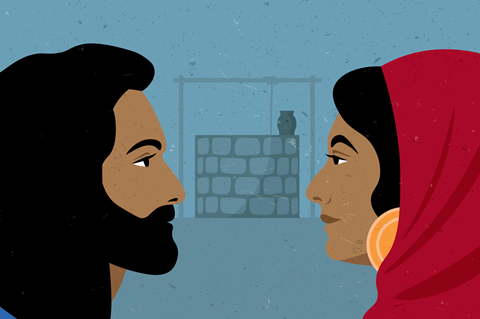This famous biblical story has long been misunderstood, says Dr Lucy Peppiatt

I wonder what you think about the Samaritan woman who meets Jesus at the well. We’re not told her name in John 4 but, in the Eastern Orthodox Church, she’s well known as St Photina, an evangelist and martyr.
Photina, they say, was either imprisoned and martyred in Carthage, North Africa or she went to Rome, where she was tortured and killed by Emperor Nero. Before she died, however, the impressive evangelist is said to have converted Nero’s daughter. This is a much more exciting story than simply leaving her as the nameless woman at the well!
Whether we think of her as St Photina or the anonymous Samaritan woman, one sad aspect of her story is that she’s often portrayed as immoral. She is known as the woman who worked her way through five husbands and was, at the time of meeting Jesus, living in sin with a sixth man.
Thankfully, this view of her has been challenged in recent years, telling a different story of her circumstances and highlighting what a unique place she holds in the spread of the gospel.
It is true that she had ended up at the bottom of the social pile – but it’s likely that this was through no fault of her own. In the ancient world, only a man could divorce a woman, and for the most insignificant of reasons. A woman had no power to challenge this. It seems this woman had either been divorced, or possibly widowed, five times, each time putting her in a terribly vulnerable position.
By rights, her extended family should have looked after her, but it seems that, after her fifth husband, her options had run out. She was fortunate to be living with a man, which provided her with some protection, but she was not a wife, just a concubine. Life had dealt her some hard blows and she had become a social outcast.
The story also tells us that Jesus, even though he clearly knew her circumstances (because he revealed them to her) both chose her and honoured her. First, he approached her for water even though the two were alone at the well. This in itself broke all social and religious taboos of the day. It was unthinkable for a Jewish man to ask a Samaritan woman for a drink of water, which she herself pointed out to Jesus.
The power of the story lies in where he went to meet his bride
John’s Gospel also tells us the disciples “were surprised” (v27) when they returned, but no one asked Jesus what he was doing. Perhaps they were embarrassed to do so. Jesus then engaged the woman in a lively debate about God and worship, as a rabbi would usually only do with a male student. Then, astonishingly, he revealed to her, a Samaritan woman, that he is the Messiah! This on its own is a radical story.
There’s a deeper layer to this tale, however, that his Jewish and Samaritan hearers would have recognised, and which sometimes gets lost today if we don’t put the conversation in its full context. Anyone familiar with the Hebrew scriptures would have known that a story which features a man, a woman and a well means a wedding! In Genesis 24, Genesis 29 and Exodus 2 we see three stories in which a groom finds a bride at a well.
Jesus met the Samaritan woman at Jacob’s well, where Jacob met Rachel (see Genesis 29). In that story, Jacob rolled the stone away at noon, or the sixth hour, the very same hour that Jesus met the woman at the very same well. Normally, women drew water from the well, but in Genesis 29, Jacob drew it. A story arose from that encounter that told of the well becoming a spring with flowing water enduring for 20 years after Jacob’s visit. So when the woman asked Jesus: “Are you greater than Jacob?” The answer was most definitely: “Yes!” Can you provide endless water? Yes! And not just for 20 years but on into eternity.
Those hearing the story, who knew the background and context, knew the symbolic message underneath. In John’s Gospel, Jesus is described by John the baptiser as the bridegroom (John 3:29). Here, we see the bridegroom not looking for an actual bride but looking for his bride, the Church. The power of the story lies in where he went to meet this bride. Jesus travelled to Samaria and began with the outcast, the woman at the bottom of the social pile. She was his chosen one. From her, the message went out to the whole village, and he stayed for two days, teaching and preaching among the outcasts, the heretics, the false worshippers, the enemies.
This is such a powerful story of forgiveness and acceptance, but especially when you realise the deeper implications of this exchange. God’s people are often cast as the unfaithful wife whom the faithful God refuses to give up on. He comes to seek his bride and, through his love and acceptance, presents her as spotless and blameless. The story of the woman at the well tells us of God’s heart and the essence of the gospel – to reverse the shame and the enmity of the world, to save the lost and to restore them to himself in covenant love.





































1 Reader's comment